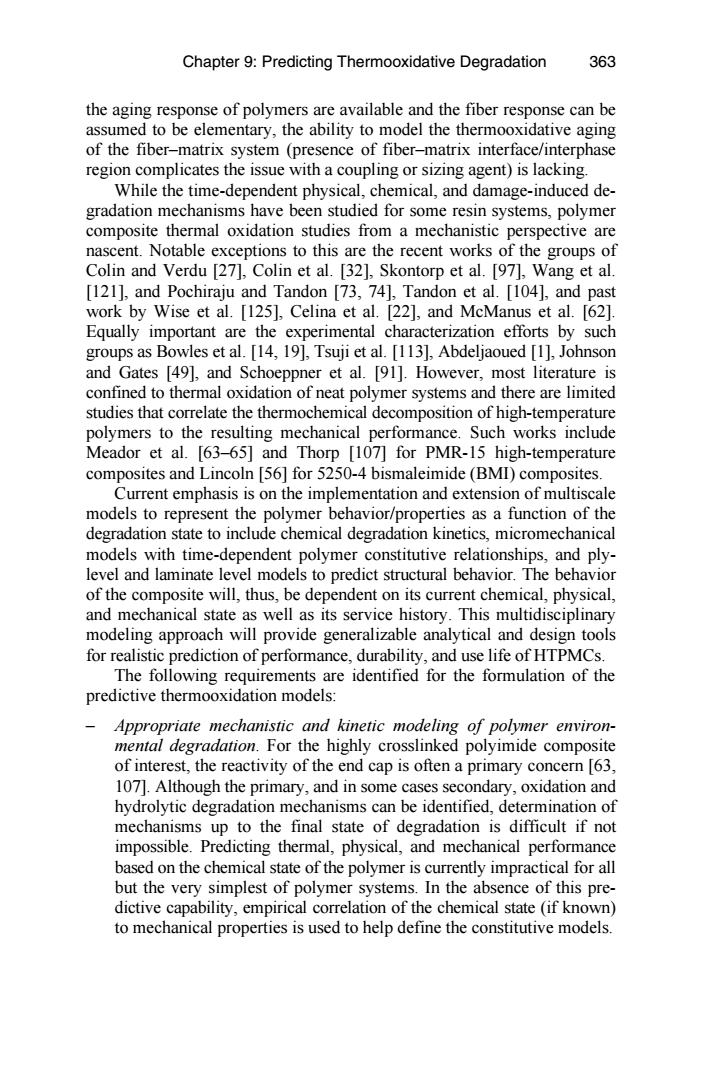正在加载图片...

Chapter 9:Predicting Thermooxidative Degradation 363 the aging response of polymers are available and the fiber response can be assumed to be elementary,the ability to model the thermooxidative aging of the fiber-matrix system (presence of fiber-matrix interface/interphase region complicates the issue with a coupling or sizing agent)is lacking. While the time-dependent physical,chemical,and damage-induced de- gradation mechanisms have been studied for some resin systems,polymer composite thermal oxidation studies from a mechanistic perspective are nascent.Notable exceptions to this are the recent works of the groups of Colin and Verdu [27],Colin et al.[32],Skontorp et al.[97],Wang et al. [1211,and Pochiraju and Tandon [73,741,Tandon et al.[1041,and past work by Wise et al.[125],Celina et al.[22],and McManus et al.[621. Equally important are the experimental characterization efforts by such groups as Bowles et al.[14,19],Tsuji et al.[113],Abdeljaoued [1],Johnson and Gates [49],and Schoeppner et al.[91].However,most literature is confined to thermal oxidation of neat polymer systems and there are limited studies that correlate the thermochemical decomposition of high-temperature polymers to the resulting mechanical performance.Such works include Meador et al.[63-65]and Thorp [107]for PMR-15 high-temperature composites and Lincoln [56]for 5250-4 bismaleimide(BMI)composites. Current emphasis is on the implementation and extension of multiscale models to represent the polymer behavior/properties as a function of the degradation state to include chemical degradation kinetics,micromechanical models with time-dependent polymer constitutive relationships,and ply- level and laminate level models to predict structural behavior.The behavior of the composite will,thus,be dependent on its current chemical,physical. and mechanical state as well as its service history.This multidisciplinary modeling approach will provide generalizable analytical and design tools for realistic prediction of performance,durability,and use life of HTPMCs. The following requirements are identified for the formulation of the predictive thermooxidation models: Appropriate mechanistic and kinetic modeling of polymer environ- mental degradation.For the highly crosslinked polyimide composite of interest,the reactivity of the end cap is often a primary concern [63, 1071.Although the primary,and in some cases secondary,oxidation and hydrolytic degradation mechanisms can be identified,determination of mechanisms up to the final state of degradation is difficult if not impossible.Predicting thermal,physical,and mechanical performance based on the chemical state of the polymer is currently impractical for all but the very simplest of polymer systems.In the absence of this pre- dictive capability,empirical correlation of the chemical state (if known) to mechanical properties is used to help define the constitutive models.the aging response of polymers are available and the fiber response can be assumed to be elementary, the ability to model the thermooxidative aging of the fiber–matrix system (presence of fiber–matrix interface/interphase region complicates the issue with a coupling or sizing agent) is lacking. While the time-dependent physical, chemical, and damage-induced degradation mechanisms have been studied for some resin systems, polymer composite thermal oxidation studies from a mechanistic perspective are nascent. Notable exceptions to this are the recent works of the groups of Colin and Verdu [27], Colin et al. [32], Skontorp et al. [97], Wang et al. [121], and Pochiraju and Tandon [73, 74], Tandon et al. [104], and past work by Wise et al. [125], Celina et al. [22], and McManus et al. [62]. Equally important are the experimental characterization efforts by such groups as Bowles et al. [14, 19], Tsuji et al. [113], Abdeljaoued [1], Johnson and Gates [49], and Schoeppner et al. [91]. However, most literature is confined to thermal oxidation of neat polymer systems and there are limited studies that correlate the thermochemical decomposition of high-temperature polymers to the resulting mechanical performance. Such works include Meador et al. [63–65] and Thorp [107] for PMR-15 high-temperature composites and Lincoln [56] for 5250-4 bismaleimide (BMI) composites. Current emphasis is on the implementation and extension of multiscale models to represent the polymer behavior/properties as a function of the degradation state to include chemical degradation kinetics, micromechanical models with time-dependent polymer constitutive relationships, and plylevel and laminate level models to predict structural behavior. The behavior of the composite will, thus, be dependent on its current chemical, physical, and mechanical state as well as its service history. This multidisciplinary modeling approach will provide generalizable analytical and design tools for realistic prediction of performance, durability, and use life of HTPMCs. predictive thermooxidation models: – Appropriate mechanistic and kinetic modeling of polymer environmental degradation. For the highly crosslinked polyimide composite of interest, the reactivity of the end cap is often a primary concern [63, 107]. Although the primary, and in some cases secondary, oxidation and hydrolytic degradation mechanisms can be identified, determination of mechanisms up to the final state of degradation is difficult if not impossible. Predicting thermal, physical, and mechanical performance based on the chemical state of the polymer is currently impractical for all but the very simplest of polymer systems. In the absence of this predictive capability, empirical correlation of the chemical state (if known) to mechanical properties is used to help define the constitutive models. The following requirements are identified for the formulation of the Chapter 9: Predicting Thermooxidative Degradation 363